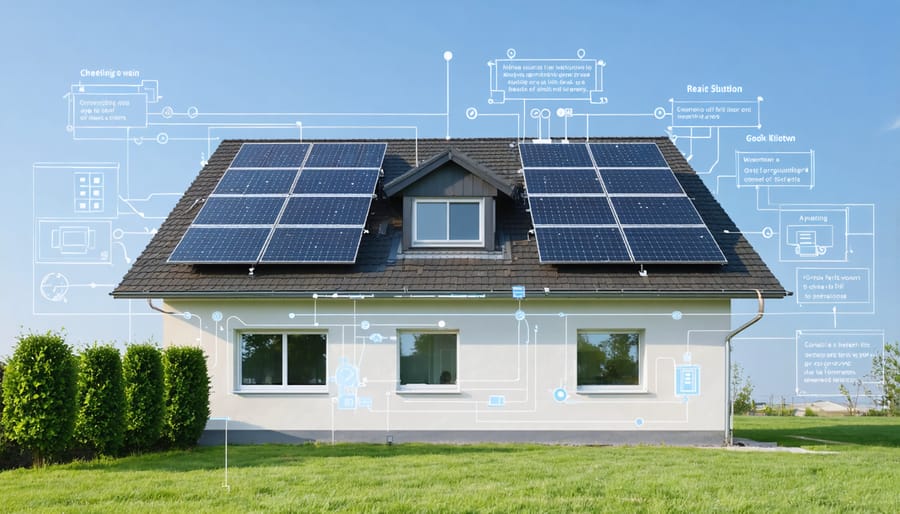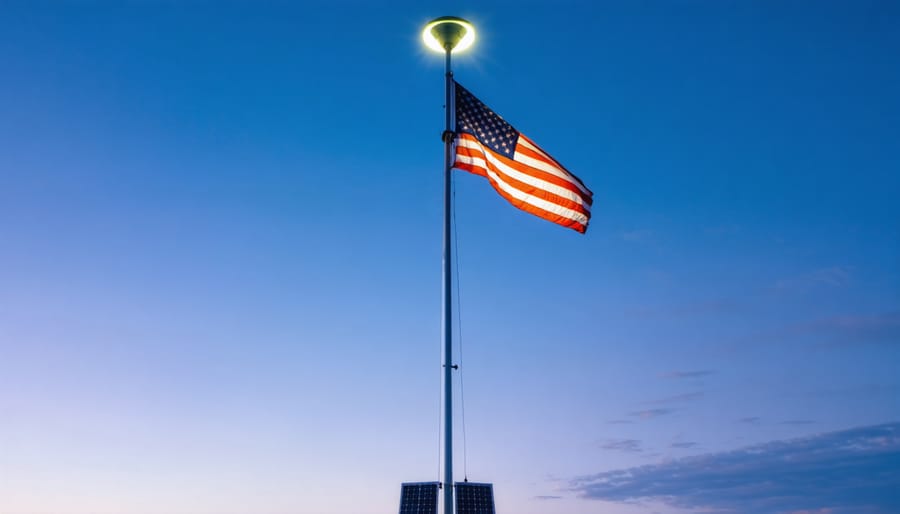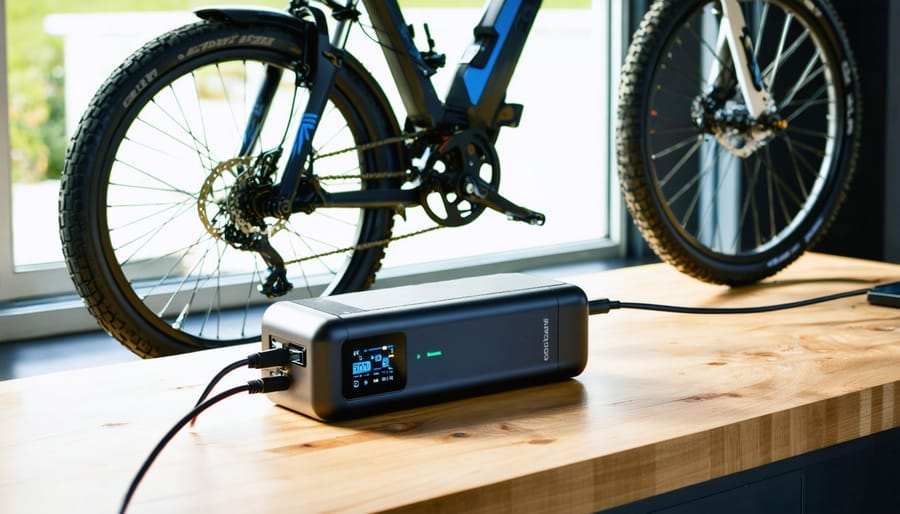Essential Residential Electric Code Rules That Keep Your Solar Installation Safe
Updated:

Mastering residential electrical code requirements safeguards your home and family while ensuring your DIY solar installation meets all legal standards. The National Electrical Code (NEC) establishes critical guidelines for everything from wire sizing and grounding requirements to proper circuit protection and disconnect placement. Whether you’re planning a new solar array or upgrading your home’s electrical system, understanding these regulations isn’t just about compliance—it’s about creating a safe, efficient, and future-proof power system.
As a DIY solar enthusiast myself, I’ve learned that residential electrical codes can seem overwhelming at first, but they’re actually your blueprint for success. They specify exact requirements for conductor ampacity, conduit fill rates, and equipment clearances that prevent common safety hazards like overheating and arc faults. Moreover, these codes are regularly updated to address emerging technologies and safety concerns, making them an essential resource for anyone working with residential electrical systems.
Stay with me as we break down the most critical residential electrical code requirements in simple, actionable terms. From proper grounding techniques to required safety disconnects, we’ll cover everything you need to know to ensure your electrical work is both safe and compliant.
Understanding NEC Requirements for Solar Installations
Key Code Updates for Solar Systems
The solar energy landscape is evolving rapidly, and recent electrical code updates reflect these changes. As someone who’s installed dozens of solar systems, I’ve noticed the most significant change is the rapid shutdown requirement, which now mandates that solar panels must be able to de-energize within 30 seconds of power loss or emergency shutdown activation.
Another crucial update affects energy storage systems. If you’re planning to add a battery backup, you’ll need to ensure it’s installed in a dedicated electrical room or garage area with proper ventilation. The code now requires clear labeling of disconnect locations and emergency shutdown procedures.
Ground-fault protection has also become more stringent. All solar installations must now include advanced ground-fault detection equipment that can identify and respond to both AC and DC ground faults. This is particularly important for preventing potential fire hazards.
For those considering microinverter systems, the code now allows for simplified rapid shutdown compliance since these systems inherently meet many of the safety requirements. Remember, though, that all equipment must be listed and labeled by a nationally recognized testing laboratory.
Looking to upgrade your existing system? Make sure to review these new requirements with your local inspector, as grandfathering clauses may apply.
Rapid Shutdown Requirements
Rapid shutdown requirements are crucial safety features in modern solar installations, designed to protect first responders and maintenance workers during emergencies. Since 2014, the National Electrical Code (NEC) has mandated that solar systems must be equipped with rapid shutdown capabilities, allowing for quick power deactivation when needed.
The system must be able to reduce voltage to 30 volts or less within 30 seconds of activation. This requirement applies to all conductors within 1 foot of the array and within 3 feet of entry into the building. As a DIY enthusiast myself, I can’t stress enough how important it is to understand these requirements before starting any solar project.
Your rapid shutdown system should include clearly labeled switches, typically placed near your electrical service panel or in another easily accessible location. When working with your system, always follow proper procedures for disconnecting solar panels safely to prevent any accidents.
Remember, while the technical aspects might seem overwhelming at first, these requirements exist to protect both you and emergency responders. Local building departments often have specific guidelines, so always check your area’s requirements before installation.

Critical Wiring and Connection Standards
Conductor Sizing and Protection
When it comes to residential electrical work, selecting the right conductor size and protection is crucial for safety and code compliance. I remember learning this lesson the hard way when I first started working with solar installations – using the wrong wire size can lead to overheating and potential fire hazards.
The National Electrical Code (NEC) provides specific guidelines for conductor sizing based on the circuit’s ampacity (current-carrying capacity) and voltage drop considerations. For most residential circuits, you’ll typically use copper conductors rated at either 60°C or 75°C. The ampacity tables in NEC Article 310 are your go-to reference for selecting the right wire size.
Circuit protection is equally important. Every circuit needs proper overcurrent protection through circuit breakers or fuses. The protection device’s rating must not exceed the conductor’s ampacity rating. For example, a 20-amp circuit requires at least 12-gauge wire, while a 15-amp circuit can use 14-gauge wire.
When working with solar installations, ensuring proper MC4 connector installation is essential for maintaining circuit integrity. Always remember to account for temperature derating factors and voltage drop, especially for longer runs.
Pro tip: When in doubt, it’s better to size up rather than down. While it might cost a bit more upfront, using larger conductors can improve system efficiency and provide better safety margins.

Grounding Requirements
Proper grounding is crucial for any residential electrical system, serving as your home’s primary safety mechanism against electrical faults and surges. As a DIY enthusiast who’s helped countless homeowners with their solar installations, I can’t stress enough how important it is to get this right.
Your grounding system must include a grounding electrode conductor (GEC) connected to an approved grounding electrode, typically a copper-clad ground rod driven at least 8 feet into the earth. The GEC must be sized according to the largest service conductor, but it’s never smaller than #6 copper. From my experience, most residential installations use #4 copper for added safety margin.
The service panel requires specific neutral and ground bonding requirements that must be followed precisely. In the main service panel, the neutral and ground bars are bonded together, but in sub-panels, they must remain separate to prevent dangerous current paths.
All metal components of your electrical system need to be properly bonded, including metal water pipes within 5 feet of where they enter the building, metal gas piping, and other metal systems. Use approved grounding clamps and ensure all connections are tight and corrosion-resistant.
Remember, while grounding might seem simple, it’s one of the most critical aspects of electrical safety. When in doubt, always consult a licensed electrician to verify your work meets local code requirements.
Safety Equipment and Disconnect Requirements
Placement of Disconnects
When it comes to electrical disconnects in your home solar setup, proper placement isn’t just about convenience – it’s a crucial safety requirement. The main service disconnect must be readily accessible and located either outside the building or inside nearest the point of entrance of the service conductors. I learned this firsthand when helping a neighbor with their solar combiner box installation, where accessibility was key to meeting code requirements.
Your disconnect should be installed at a height between 3 and 6.5 feet from the ground, making it easily reachable in emergencies. It’s important to ensure the area around the disconnect remains clear – no storing boxes or equipment that might block access! The disconnect location should also be clearly marked and visible to emergency responders.
For homes with multiple electrical services or solar systems, each disconnect must be grouped together when possible, unless specific conditions require separation. Remember, the goal is to ensure that anyone who needs to cut power quickly can do so without confusion or delay.
Labeling and Marking
Proper labeling and marking of your electrical system isn’t just about staying code-compliant – it’s about keeping everyone safe. Every electrical panel must have clear, permanent labeling that identifies the main service disconnect, branch circuits, and their corresponding locations. Each circuit breaker should be accurately labeled with what it controls, making it easy to identify which switch powers what area of your home.
Warning labels are particularly crucial. You’ll need to display appropriate warnings for arc flash hazards, and if your home has multiple service entrance points, each needs clear identification. For solar installations, special labeling requirements include marking the AC disconnect switch, identifying solar power sources, and displaying warning signs about the presence of both AC and DC power.
Here’s something I learned during my own installations: using a label maker and clear plastic covers helps ensure your markings stay legible for years. Remember to use weather-resistant labels for outdoor components and avoid handwriting, which can fade or become illegible over time. Keep your labels simple, clear, and positioned where they’re easily visible – even in low-light conditions.

Adhering to electrical residential codes isn’t just about following rules – it’s about ensuring the safety and well-being of everyone in your home. Throughout this guide, we’ve covered essential aspects of residential electrical codes, from proper wiring techniques to grounding requirements and circuit protection. Remember, while DIY electrical work can be rewarding, it’s crucial to stay within your skill level and always consult professionals when needed. Keeping up with code requirements might seem overwhelming at first, but it’s an investment in your home’s safety and value. Whether you’re planning a simple upgrade or a complete solar installation, always double-check local regulations and obtain necessary permits. As one of my customers once told me, “It’s better to spend extra time following codes now than dealing with problems later.” Stay safe, stay compliant, and enjoy the benefits of proper electrical installations in your home.










